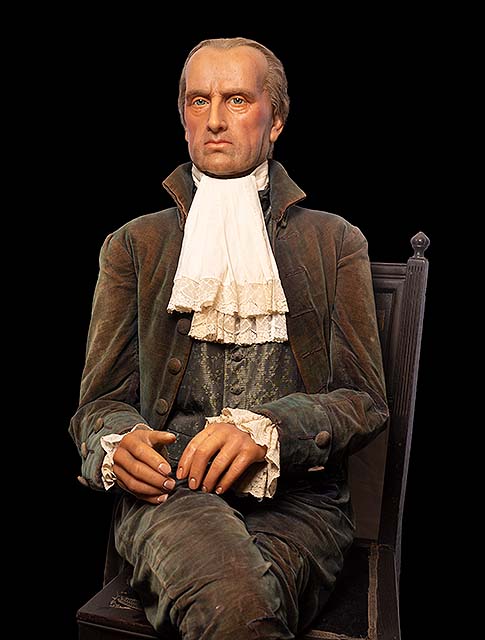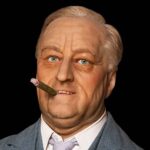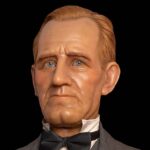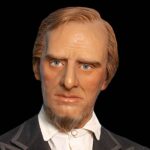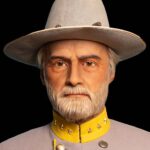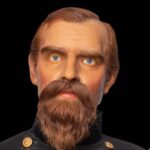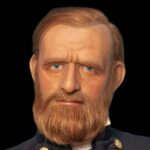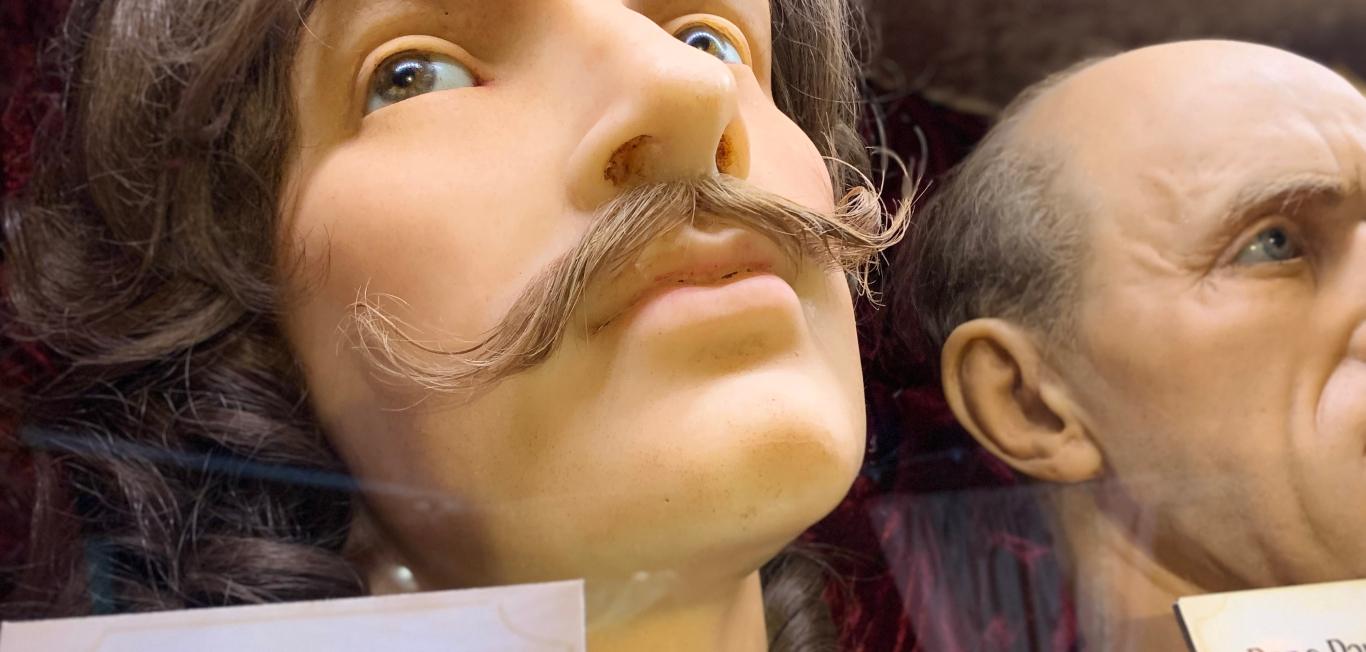Biography of James Madison
James Madison began his political career with the Orange County Committee of Safety in 1774. In the following years, he would quickly become an important political figure, his intelligence and carefully crafted arguments making him a standout in early American politics. From the Virginia legislature to the Founding Fathers to the President, Madison was instrumental in the development of the United States, laying the groundwork for a successfully functional government that has held strong for over two centuries.
Despite living a life plagued with sickness and fragility, Madison didn’t let anything hold him back in the pursuit of knowledge and greatness. With many key roles in various forms of government, both local and federal, both legislative and executive, and both pre- and post-Constitution, his legacy is undeniable as one of the greatest political founders of the American nation.
Together with historically influential friends and colleagues like Thomas Jefferson and Alexander Hamilton, the Founding Fathers (Madison included) were able to unite the American colonies and save them from a failing government under the Articles of Confederation, building the necessary foundation to turn the United States into the global superpower it is today.
James Madison died on June 28, 1836, at the age of 85, in his lifelong family estate, Montpelier. He is remembered not only as a Founding Father but also as the Father of the U.S. Constitution, playing a key role in the development of its design and the first ten amendments, also known as the Bill of Rights. As the fourth president of the United States, he is known for leading the country against Great Britain in the War of 1812 (or the “Second War of Independence”), in what is considered by the American people a win for the country.
DID YOU KNOW?
As the fourth president of the United States, Madison is known for leading the country against Great Britain in the War of 1812
Interesting Facts
Usually, coming from a wealthy family in Virginia, Madison would have attended William and Mary, just as presidents Thomas Jefferson, James Monroe, and John Tyler did. However, due to his sickly nature, he was advised not to, as malaria was common in that area, leading him to attend the College of New Jersey instead.
James Madison lost re-election to Virginia’s legislature after serving in 1776 because of his refusal to give electors free whiskey.
At twenty-nine years old, Madison was the youngest delegate to serve in the Continental Congress in 1780.
James Madison’s doctor offered to extend his life so that he could die on July 4th, 1836, since fellow presidents John Adams, Thomas Jefferson, and James Monroe all died in previous years on Independence Day. Madison declined and died six days before the 60th anniversary of the nation’s birth.
Madison fell into substantial debt after his alcoholic stepson, John Payne Todd, got into heavy gambling and crime. It got so bad that Madison had to mortgage off his family estate, Montpelier, and his wife, Dolley Payne Madison, had to sell the plantation to cover Todd’s debts after James Madison had died.
Early Life of James Madison
James Madison was born on March 16, 1751, in Port Conway, Virginia, to parents James and Nelly Madison as the first of their 12 children. His father, James Sr., was a wealthy Virginia tobacco planter and slave owner. In the early 1760s, the family moved into their newly constructed estate, Montpelier, built in Orange County, Virginia, which would become Madison’s lifelong residence. Madison would go on to inherit Montpelier and over 100 enslaved individuals with it after his father’s death in 1801.
Madison enjoyed a comfortable childhood, with access to a rich education that would lead him to the College of New Jersey (now known as Princeton University) in 1769, graduating early two years later in 1771 with high interest and scores in classical languages, mathematics, rhetoric, geography, and philosophy. Wanting to further his education beyond his first degree, Madison chose to remain at the College of New Jersey, studying Hebrew and political philosophy under university president John Witherspoon as its first graduate student.
Madison wasn’t in the greatest health throughout the course of his life. He is known for being the shortest president at five feet and four inches, with a weight that usually remained under 100lbs. He was often referred to as appearing naturally sickly or frail, and it is still unclear what he might have suffered from today. It’s possible that Madison might have had some sort of seizure disorder, although it is debated whether or not it stemmed from psychiatric or physical causes.
As early as his college days, Madison was a strong advocate for the independence of the American colonies from Great Britain’s influence. He would often demonstrate against England, making his transition into politics almost inevitable when paired with his educational interests. In 1774, Madison would join the Orange County Committee of Safety. Two years later, in 1776, he was elected to Virginia’s Revolutionary convention (which would turn into Virginia’s legislature) where he drafted the state’s guarantee of religious freedom. At this time, he also met Thomas Jefferson, Founding Father and the third U.S. president, working together to disestablish the church.
When Jefferson was elected as Governor of Virginia in 1779, Madison served on his council for two years before being sent to the Continental Congress in March of 1780, where he would represent Virginia until 1783. In 1784, he would re-enter the Virginia legislature, again taking up the fight against religious influence as he defeated Patrick Henry’s bill to give financial support to Christian educators.
DID YOU KNOW?
As early as his college days, Madison was a strong advocate for the independence of the American colonies from Great Britain’s influence.
Taking notice of the cracks beginning to form in the original design of the government under the Articles of Confederation, Madison convinced John Tyler to sponsor the 1786 Annapolis Convention, which played a big role in the organization of a federal convention, specifically the historical Constitutional Convention of 1787, to discuss the flawed Articles.
The Articles of Confederation
The Articles of Confederation served as the first U.S. constitution from 1781 to 1789, a metaphorical bridge between the government established by the Continental Congress after the Revolutionary War and the federal government established under the U.S. Constitution of 1787. Actively fighting against Great Britain’s rule, which operated under central authority, the American colonies drafted the Articles to establish a confederation of sovereign states, giving their central government very little power over the independent laws and actions of each state.
On paper, the Congress of Confederation had power over foreign affairs, Native American affairs, war, the postal service, the appointment of military officers, and the determination of the value of coin. However, the Articles failed to give Congress the power it needed to enforce its requests to the states for money and troops, making it hard to pay off debt and organize the military across all 13 states properly. By 1786, it was clear that the government was highly ineffective, leading to the organization of the Constitutional Congress of 1787 to amend the Articles.
To note: The 13 colonies, and eventual first U.S. states, included Virginia, Massachusetts, New Hampshire, New York, Maryland, Connecticut, Rhode Island, Delaware, North Carolina, New Jersey, South Carolina, Pennsylvania, and Georgia.
James Madison and the U.S. Constitution
At the Constitutional Convention of 1787, James Madison’s Virginia Plan was presented to the delegation. This plan was one of two major proposals for the framework of the future U.S. government, focusing on a strong central government with three branches: the executive, the legislative, and the judicial. These branches would work in a system of checks and balances that would help distribute power and prevent one branch from wielding too much power on its own. This plan is also referred to as the “Large-State Plan”, as another one of its big propositions was for the bicameral (or two-house) legislative branch to be based on proportional representation, favoring larger states as they would receive more representatives than smaller states in the legislature. The Virginia Plan received a lot of initial pushback, especially from those smaller states.
To counter this plan, the New Jersey Plan was created, introducing the three-fifths rule and calling for multiple executive branch leaders and a legislative branch built on equal representation. The three-fifths rule, for context, counted three-fifths of a state’s enslaved people towards the overall population to help determine taxation and representation in its legislature. This plan also brought a lot of concerns, specifically from Alexander Hamilton, who was a big part of the New Jersey Plan’s failure in the convention.
With both major plans facing heavy backlash and concern, Connecticut introduced its Great Compromise (or the Connecticut Compromise), which took inspiration from the Virginia and New Jersey Plans to come to a middle ground. From the Virginia Plan, Madison’s brainchild, the three-branch system would be built upon, with the lower house of the legislative branch (the House of Representatives) basing representation on population, as originally proposed. From the New Jersey Plan, the three-fifths rule was adopted, with the upper house of the legislative branch (the Senate) dividing representation equally between each state.
With the Great Compromise came a Constitution that all states could be content with. However, it still had to be ratified, and there were still concerns about how the nation would function under this new government. This is where the Federalist Papers were born, with James Madison, Alexander Hamilton, and John Jay taking on the pseudonym “Publius” as a collective to publish 85 essays (originally meant to be twenty-five equally divided between the three men) between 1787 and 1788 in New York to promote ratification of this new Constitution. James Madison wrote 29 of the essays and was able to successfully see Virginia ratify the Constitution.
Under the convention, it was agreed that nine of the states would have to ratify the Constitution before it could be considered accepted. On June 21, 1788, with New Hampshire’s ratification (the ninth state), the Constitution was officially made the framework for the country’s government.
DID YOU KNOW?
James Madison wrote 29 of the essays and was able to successfully see Virginia ratify the Constitution.
Elected to the new House of Representatives (the lower house), Madison emerged as a leader as he began to sponsor the Bill of Rights, or the first ten amendments of the Constitution, although he considered them unnecessary at first. He originally compiled a list of nineteen proposals from the hundreds of suggestions seen in ratification debates, but only twelve were turned into amendments, and only ten were ratified by the states.
The most commonly known and discussed amendments today of the Bill of Rights include the first amendment (freedom of religion, speech, press, assembly, and petition), the second amendment (the right to bear arms), and the sixth amendment (the right to a speedy and fair trial; also implies innocent before proven guilty). The Bill of Rights was ratified on December 15, 1791.
While in the House of Representatives, Madison saw a split from his previous partner, Hamilton (now Secretary of the Treasury), as they faced conflict over how to fund war debts. While Hamilton wanted to strengthen the government by cementing men of wealth to it, Madison wanted to focus more on protecting Revolutionary War veterans. Ultimately, Hamilton won this battle, splitting Congress into Madisonian and Hamiltonian factions.
In 1794, Madison would marry young Quaker widow Dolley Payne Todd, who had just recently lost her previous husband and youngest son in a yellow fever epidemic in Philadelphia. Because Madison was not a Quaker (a Christian denomination family), Dolley was expelled from the Society of Friends. The newlywed couple would go on to raise Dolley’s surviving son, John Payne Todd, in Philadelphia until 1797 before they moved back to Montpelier.
James Madison left Congress in 1797 after serving four full terms. With the intent to retire from politics after his time with Congress, he was dragged back to Washington, D.C. when his old friend and new president, Thomas Jefferson, named him Secretary of State in 1801. In his new position, Madison argued for American shipping rights as a neutral party to the war between France and Great Britain, and also assisted in orchestrating the Louisiana Purchase. There, he remained under President Jefferson until his second term was complete in 1809, with Madison being the clear choice for the next presidency in his political party, the Democratic-Republicans.
James Madison’s
Presidency
James Madison won the presidency from Federalist candidate Charles Cotesworth Pinckney in 1808, officially taking office in early 1809 and becoming the fourth president of the United States. For two years, Madison wrote all diplomatic letters for his Secretary of State, Robert Smith, before finally replacing him in 1811 with future president James Monroe. Around this time, there was much conflict surrounding the U.S., France, and Great Britain concerning wartime shipping and commerce, as France and Great Britain were at war (the Napoleonic Wars), as both countries tried blocking the U.S. from trading with the other.
DID YOU KNOW?
Madison won the presidency in 1808, becoming the fourth president of the United States.
This continuous maritime conflict, paired with Great Britain forcing American sailors into service and arming Native Americans to attack U.S. settlers, eventually led Madison to send a war message to Congress on June 1, 1812, with the vote dividing both the House and the Senate. On June 18, 1812, President Madison declared war on Great Britain (also referred to as the “Second War of Independence”), attacking Canada almost immediately, since it was a British colony at the time.
Unfortunately for the nation, the U.S. had all of the spirit but not enough resources to be fully prepared for a war. Initially, military efforts were clumsy, with Madison relying on old generals from the Revolutionary period. However, he did eventually lower the age of generals from 60 to 36 in 1814, which saw multiple victories in the war for the United States. Just as it started to look good for the U.S., Great Britain finally defeated Napoleon’s armies in April 1814, allowing them to turn their full attention to war efforts in America.
In one of the most shocking moves of the war, British forces invaded the Chesapeake Bay and captured Washington D.C., on August 24, 1814, burning down multiple governmental buildings, including the Capitol and the White House, two of the most significant and symbolic buildings in the country. This was a devastating loss for James Madison, although his wife, Dolley Payne Madison, had the foresight to order all valuables out of Washington before British troops arrived.
Dolley Payne Madison is also considered to be the woman who shifted the “First Lady” title into a position of political effect and power, as she turned the White House into a place of hospitality for politicians and their spouses to discuss matters in a civil and diplomatic way, even when they had opposing views.
The War of 1812 ended on December 24, 1814, after the United States signed the Treaty of Ghent with Great Britain in Belgium. While pre-war concerns about American impressment and the rights of neutral U.S. vessels were not mentioned in the treaty, the Great Lakes were opened for American expansion, which was widely considered a success in America. However, despite the signing of this treaty, word of peace didn’t actually reach the countries until nearly two months later. As a result, British forces attacked New Orleans on January 8, 1815, facing crushing defeat under future president General Andrew Jackson’s hand. This was also considered a great win for the U.S., bolstering American confidence and pride despite the war technically being over at the time.
After the war, the Federalist Party, which Madison had openly fought against, was all but destroyed, as they had heavily opposed the war. Madison was received positively by the American people, as they believed he had won national glory and power, despite there not being a definitive winner of the War of 1812. With the completion of his second term in 1817, James Madison retired to his family home, Montpelier, in Virginia.
Late In Life
After retiring to Montpelier at the age of 65 in 1817, James Madison spent the rest of his life in Virginia, cultivating his farmlands at the plantation to grow wheat and tobacco. Unfortunately, due to weather, pests, and market prices, profits were low. In 1819, he helped advise Thomas Jefferson’s creation of the University of Virginia, serving as its rector in 1826 as Jefferson’s successor after his death the same year.
DID YOU KNOW?
Madison helped advise Thomas Jefferson’s creation of the University of Virginia.
Ironically, while he was vocal in his distaste for slavery in his later years, Madison didn’t free his slaves upon death like many expected him to, or as George Washington and Thomas Jefferson did. He simply left them in his widow’s care, requesting that she not sell off any enslaved people without their consent, a wish she ultimately did not honor. While he was still alive, Madison advocated for the abolishment of slavery through government purchase of enslaved people, seeking their resettlement in African colonies, which never came to fruition.
The older Madison got, the worse his finances were, with the constant hospitality, agricultural failure, care of his older slaves, and a gambling-addicted stepson proving to be a drain. By the end of his life, Madison was poor, spending most of his time bedridden, barely able to move as he grew weak from rheumatoid arthritis. On June 28, 1836, James Madison passed away peacefully from natural causes over breakfast in his Montpelier home at the age of 85. He is remembered for his deep intelligence and spark for political debate and growth, nicknamed the “Father of the Constitution”, a title he humbly did not want to claim during his life. Without this great Founding Father and president, the construction of the current American government would have looked remarkably different, cementing his place as one of the historical greats of his nation.
FAQs
How did James Madison die?
On June 28, 1836, James Madison died sitting over his breakfast, passing away peacefully of natural causes. Despite being sickly throughout his whole lifetime, he lived a substantial 85 years, although many of those final ones were spent bedridden, barely able to move after he grew weak from rheumatoid arthritis.
What did James Madison write?
James Madison wrote 29 of the 85 essays of the Federalist Papers, which were published between 1787 and 1788 in New York under the pseudonym “Publius” to persuade voters to support the ratification of the new U.S. Constitution. Co-writers Alexander Hamilton and John Jay wrote 51 and five of the other essays, respectively.
What is James Madison best known for?
James Madison is best known for being the Father of the Constitution, as his Virginia Plan laid the groundwork for the U.S. Constitution and was instrumental in the development of our three branch governmental system (consisting of the executive, legislative, and judicial branches) and first ten amendments, also known as the Bill of Rights.
What were James Madison’s last words?
James Madison’s last words were, “Nothing more than a change of mind, my dear. I always talk better lying down.” As the Madison family gathered around his deathbed, these words were spoken to his niece after she noticed a shift in his expression, asking him, “What is the matter?”
What was James Madison’s political affiliation?
James Madison was a Democratic-Republican, a party he founded with Thomas Jefferson in 1792 to directly oppose the Federalist Party. The party mainly supported states’ rights, individual liberty, equal rights, religious freedom, and a strict interpretation of the Constitution. It is the antecedent of today’s Democratic Party.
